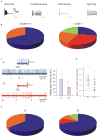Redefining the cerebellar cortex as an assembly of non-uniform Purkinje cell microcircuits
- PMID: 25601779
- PMCID: PMC4476393
- DOI: 10.1038/nrn3886
Redefining the cerebellar cortex as an assembly of non-uniform Purkinje cell microcircuits
Abstract
The adult mammalian cerebellar cortex is generally assumed to have a uniform cytoarchitecture. Differences in cerebellar function are thought to arise primarily through distinct patterns of input and output connectivity rather than as a result of variations in cortical microcircuitry. However, evidence from anatomical, physiological and genetic studies is increasingly challenging this orthodoxy, and there are now various lines of evidence indicating that the cerebellar cortex is not uniform. Here, we develop the hypothesis that regional differences in properties of cerebellar cortical microcircuits lead to important differences in information processing.
Figures





References
-
- Eccles JC, Ito M, Szentágothai J. The Cerebellum as a Neuronal Machine. Springer-Verlag; Berlin: 1967.
-
- Palay SL, Chan-Palay V. Cerebellar cortex: cytology and organization. Springer; Berlin: 1974.
Publication types
MeSH terms
Grants and funding
LinkOut - more resources
Full Text Sources
Other Literature Sources

